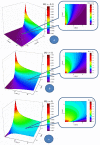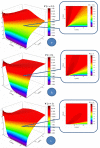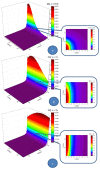Multifractality through Non-Markovian Stochastic Processes in the Scale Relativity Theory. Acute Arterial Occlusions as Scale Transitions
- PMID: 33918896
- PMCID: PMC8069992
- DOI: 10.3390/e23040444
Multifractality through Non-Markovian Stochastic Processes in the Scale Relativity Theory. Acute Arterial Occlusions as Scale Transitions
Abstract
By assimilating biological systems, both structural and functional, into multifractal objects, their behavior can be described in the framework of the scale relativity theory, in any of its forms (standard form in Nottale's sense and/or the form of the multifractal theory of motion). By operating in the context of the multifractal theory of motion, based on multifractalization through non-Markovian stochastic processes, the main results of Nottale's theory can be generalized (specific momentum conservation laws, both at differentiable and non-differentiable resolution scales, specific momentum conservation law associated with the differentiable-non-differentiable scale transition, etc.). In such a context, all results are explicated through analyzing biological processes, such as acute arterial occlusions as scale transitions. Thus, we show through a biophysical multifractal model that the blocking of the lumen of a healthy artery can happen as a result of the "stopping effect" associated with the differentiable-non-differentiable scale transition. We consider that blood entities move on continuous but non-differentiable (multifractal) curves. We determine the biophysical parameters that characterize the blood flow as a Bingham-type rheological fluid through a normal arterial structure assimilated with a horizontal "pipe" with circular symmetry. Our model has been validated based on experimental clinical data.
Keywords: Bingham fluid; acute arterial occlusion; multifractality; non-Markovian stochastic process; scale relativity theory.
Conflict of interest statement
The authors declare no conflict of interest.
Figures








References
-
- Kucaba-Piętal A. Blood as Complex Fluid, Flow of Suspensions; Proceedings of the Blood Flow-Modelling and Diagnostics: Advanced Course and Workshop-BF 2005; Warsaw, Poland. 20–23 June 2005.
-
- Fung Y.C. Biomechanics: Circulation. Springer; New York, NY, USA: 1996.
-
- Guyton A.C., Hall J.E. Textbook of Medical Physiology. 9th ed. W.B. Sanders Company; Philadelphia, PA, USA: 1996.
-
- Munson B.R., Young D.F., Okhshi T.H. Fundamentals of Fluid Mechanics. Wiley; New York, NY, USA: 1998.
-
- Bar-Yam Y. Dynamics of Complex Systems. Addison-Wesley; Reading, MA, USA: 1997. The Advanced Book Program.
LinkOut - more resources
Full Text Sources
Other Literature Sources

